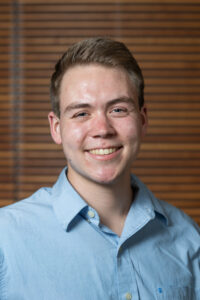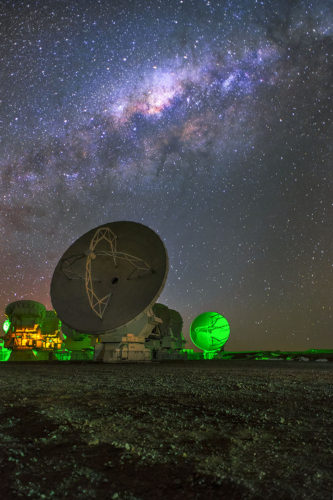
Congrats to physics graduate student Stephen McKay on being named an ALMA ambassador!
ALMA, or the Atacama Large Millimeter/submillimeter Array, is the largest radio telescope in the world. It can detect light radiated by clouds of dust grains in some of the earliest and most distant galaxies in the Universe. Researchers can submit proposals to ALMA that direct data collection to observe astronomical targets at a wide range of wavelengths, in order to accomplish many cutting-edge science goals. However, ALMA receives many more proposals than there is time to operate the telescope.
That’s where McKay’s ambassadorship comes in.
“Lots of groups at UW–Madison and other places will propose to get data from these telescope arrays,” McKay says. “In February, I’ll attend a training (through the ambassador program) where they will teach me tips and tricks for writing proposals. Then in early spring, I’ll run a proposal workshop here for anyone who wants to learn how to strengthen a proposal.”

McKay is no stranger to proposing and using ALMA data. A third-year graduate student in astronomy professor Amy Barger’s research group, he expects nearly all his publications will be based on ALMA data. His research focuses on old, distant galaxies and measuring and inferring physical properties about them: How massive are they? What is their rate of star formation? What processes trigger the rapid star-formation in these systems?
“The galaxies that I mainly study are faint or hard to detect in optical wavelengths or even near-infrared wavelengths. Until about maybe 25 years ago, we didn’t know a lot of these galaxies existed because they just weren’t visible in the typical telescope images we had,” McKay says. “The portion of the observed electromagnetic spectrum where these galaxies are brightest ranges from 500 microns to nearly one millimeter, which overlaps heavily with ALMA’s spectral coverage.”
Two years ago, McKay attended an ALMA workshop to learn more about how ALMA and similar radio arrays operate. With this ALMA ambassadorship, he will now help run the workshops and offer advice on crafting stronger proposals. The ALMA Ambassador Program is run through the National Radio Astronomy Observatory’s North American ALMA Science Center (NAASC). It provides training and an up to $10,000 research grant to early-career researchers interested in expanding their ALMA/interferometry expertise and sharing that knowledge with their home institutions.
“This program is helpful for me because I will learn more in terms of how to actually do my own research, but then I can also pass along what I learn with the rest of the astronomical community,” McKay says.